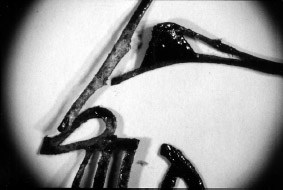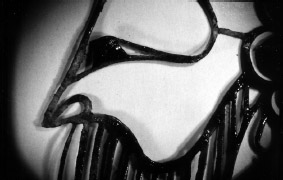CONSERVATION OF CHINESE SHADOW FIGURES: INVESTIGATIONS INTO THEIR MANUFACTURE, STORAGE, AND TREATMENTLISA KRONTHAL
5 TREATMENTDuring the rehousing, a survey of the entire collection was conducted in order to prioritize treatment. The survey results were entered into a database created specifically for the collection. It was found that more than 300 of the approximately 1,500 puppets were considered first priority, and most were in need of treatment. These puppets often required the removal of old storage materials stuck in the coating, mending of tears within the skin, or reattaching separated elements. Solubility tests on the coating revealed that it was soluble, in varying degrees, in a wide range of solvents. Acetone and ethanol solubilized the coating readily, toluene, petroleum benzine, and xylene moderately, and Stoddard solvent minimally. In most cases, the coating had saturated the storage material, and separation would inevitably involve some loss of coating. The goal in removal of the storage materials from the puppet surfaces was to retain as much of the original coating as possible along with its original, reticulated texture. By wetting the papers with Stoddard solvent, a scalpel could be inserted at the interface of the coating and the paper, and, in most cases, the paper could be removed with minimal loss of oil. The Stoddard solvent appeared to function mostly as a lubricant enabling separation of the layers while retaining the original surface texture of the coating. 5.1 MENDING TEARS IN TRANSLUCENT SKIN: LINING OPTIONSThe goals in mending were to find a combination of materials that was compatible with the skin and oiled substrate and that would maintain the transparency
The collagens were given primary consideration due to their visual and chemical compatibility with the skin substrate. Several concerns developed when considering the use of the sausage casings in this treatment. The preparation of the collagen in manufacturing a casing involves reducing bits of animal skin (generally cowhide) in hydrochloric acid, spinextruding the gelled product, bathing it in aluminum sulfate, buffering it, and adding plasticizers, consolidants, and tanning agents (Morrison 1986). These steps, especially the acid preparation, reduce the length of the collagen fibers, resulting in a product that has a very short shelf life and quickly becomes brittle upon removal from the package (Woods 1997). Requirements for a stable, flexible mend led to the elimination of this product as an option. The natural skin condoms were more promising. The intestinal material used in their manufacture comes from the cecum of the large intestine of sheep or lamb. The processes involved in its preparation include trimming and defatting of the skin, soaking it in salt solutions, addition of surfactants, light tanning, and coating with a lubricant that can be removed with acetone or ethanol. There is no acid preparation involved, as maintenance of strength and endurance are crucial requirements for such products. Unfortunately, for use on the puppets, the final product is too thick and does not lead to visually acceptable results, but it may be useful for other types of mending that require more thickness or strength.
It was concluded that goldbeater's skin resulted in successful mends that were strong, unobtrusive, and transparent. Talas supplies sheep appendix goldbeater's skin, but other suppliers will carry skin made from the cecum of intestinal material. Before use, it must be degreased using acetone and its surfaces lightly abraded with pumice to reduce unevenness. The final product is much thinner and more transparent than any of the other products considered. It can be toned with dyes in order to achieve desired colors while maintaining translucency. Orasol dyes in ethanol were used for this purpose. 5.2 ADHESIVE OPTIONSSeveral adhesives in both film and solvent form were tested in conjunction with the goldbeater's skin lining. Requirements of the adhesive include compatibility with the skin, the coating, and the lining material, as well as long-term stability, transparency, and flexibility. Included in these categories were gelatin, Beva 371, polyvinyl acetate resins, and Paraloid F-10. After a number of trials, it was found The long-term stability of adhesives in a low pH environment, like that created by skin or oil, is an area that needs investigation and research. Most of the research to date tends to focus on how adhesives age in neutral pH environments. Experiments currently are being developed in the conservation laboratories at the AMNH that will attempt to determine the aging properties of commonly used adhesives for skin repair. 5.3 THE MENDING PROCESSPrior to applying mending materials, the oil in the mend locations was reduced. Since the oil penetrates into the porous skin, it is impossible to remove completely. If necessary, the area to be mended can be relaxed into position using controlled humidification techniques, then dried under pressure. (Humidification techniques involve layering Goretex, slightly dampened blotter, and plastic over the distorted area. Generally, the skin reacts to humidification readily, and this step needs to be closely monitored to avoid wetting the skin.) Often, both sides of a tear will need the reinforcement offered by the mending materials. The final mended tear is strong, clear, and flexible (fig. 7, 8). |

